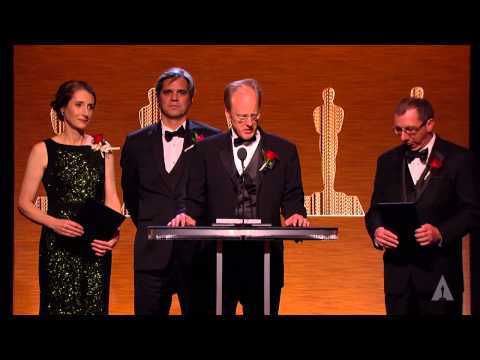Academy President Cheryl Boone Isaacs and Academy Governor Richard Edlund open the Academy's Scientific & Technical Awards
Margot Robbie and Miles Teller present a Technical Achievement Award to Peter Braun for the concept and development of the MAT-Towercam Twin Peek, a portable, remote-controlled, telescoping column that smoothly positions a camera up to 24 feet vertically.
Technical Achievement Awards are presented to Cary Phillips, Nicolas Popravka, Philip Peterson and Colette Mullenhoff for the architecture, development and creation of the artist-driven interface of the ILM Shape Sculpting System.
Gordon E. Sawyer Award
David W. Gray
Given to an individual in the motion picture industry whose technological contributions have brought credit to the industry.
Technical Achievement Award (Academy Certificate)
To Peter Braun for the concept and development of the MAT-Towercam Twin Peek, a portable, remote-controlled, telescoping column that smoothly positions a camera up to 24 feet vertically.
This small cross-section system from Mad About Technology can operate from above or below the camera, achieving nearly impossible shots with repeatable movements through openings no larger than the camera itself.
To Robert Nagle and Allan Padelford for The Biscuit Jr. self-propelled, high-performance, drivable camera and vehicle platform.
The Biscuit Jr.'s unique chassis and portable driver pod enables traveling photography from a greater range of camera positions than previously possible, while keeping actors safe and the rig out of frame.
To Harold Milligan, Steven Krycho and Reiner Doetzkies for the implementation engineering in the development of the Texas Instruments DLP Cinema digital projection technology.
Texas Instruments' color-accurate, high-resolution, high-quality digital projection system has replaced most film-based projection systems in the theatrical environment.
To Cary Phillips, Nicolas Popravka, Philip Peterson and Colette Mullenhoff for the architecture, development and creation of the artist-driven interface of the ILM Shape Sculpting System.
This comprehensive system allows artists to quickly enhance and modify character animation and simulation performances. It has become a crucial part of ILM's production workflow over the past decade.
To Tim Cotter, Roger van der Laan, Ken Pearce and Greg LaSalle for the innovative design and development of the MOVA Facial Performance Capture system.
The MOVA system provides a robust way to capture highly detailed, topologically consistent, animated meshes of a deforming object. This technology is fundamental to the facial pipeline at many visual effects companies. It allows artists to create character animation of extremely high quality.
To Dan Piponi, Kim Libreri and George Borshukov for their pioneering work in the development of Universal Capture at ESC Entertainment.
The Universal Capture system broke new ground in the creation of realistic human facial animation. This technology produced an animated, high-resolution, textured mesh driven by an actor's performance.
To Marco Revelant for the original concepts and artistic vision, and to Alasdair Coull and Shane Cooper for the original architectural and engineering design, of the Barbershop hair grooming system at Weta Digital.
Barbershop's unique architecture allows direct manipulation of full-density hair using an intuitive, interactive and procedural toolset, resulting in greatly enhanced productivity with finer-grained artistic control than is possible with other existing systems.
To Michael Sechrest for the modeling design and implementation, Chris King for the real-time interactive engineering, and Greg Croft for the user interface design and implementation of SpeedTree Cinema.
This software substantially improves an artist's ability to create specifically designed trees and vegetation by combining a procedural building process with the flexibility of intuitive, direct manipulation of every detail.
To Scott Peterson, Jeff Budsberg and Jonathan Gibbs for the design and implementation of the DreamWorks Animation Foliage System.
This toolset has a hierarchical spline system, a core data format and an artist-driven modeling tool, which have been instrumental in creating art-directed vegetation in animated films for nearly two decades.
To Erwin Coumans for the development of the Bullet physics library, and to Nafees Bin Zafar and Stephen Marshall for the separate development of two large-scale destruction simulation systems based on Bullet.
These pioneering systems demonstrated that large numbers of constrained rigid bodies could be used to animate visually complex, believable destruction effects with minimal simulation time.
To Brice Criswell and Ron Fedkiw for the development of the ILM PhysBAM Destruction System.
This system incorporates innovative research on many algorithms that provide accurate methods for resolving contact, collision and stacking into a mature, robust and extensible production toolset. The PhysBAM Destruction System was one of the earliest toolsets capable of depicting large-scale destruction with a high degree of design control.
To Ben Cole for the design of the Kali Destruction System, to Eric Parker for the development of the Digital Molecular Matter toolkit, and to James O'Brien for his influential research on the finite element methods that served as a foundation for these tools.
The combined innovations in Kali and DMM provide artists with an intuitive, art-directable system for the creation of scalable and realistic fracture and deformation simulations. These tools established finite element methods as a new reference point for believable on-screen destruction.
To Magnus Wrenninge for leading the design and development of Field3D.
Field3D provides a flexible and open framework for storing and accessing voxel data efficiently. This allows interchange between previously incompatible modeling, simulation and rendering software.
To Robert Bridson for early conceptualization of sparse-tiled voxel data structures and their application to modeling and simulation.
Robert Bridson's pioneering work on voxel data structures and its subsequent validation in fluid simulation tools have had a significant impact on the design of volumetric tools throughout the visual effects industry.
To Ken Museth, Peter Cucka and Mihai Aldén for the creation of OpenVDB.
OpenVDB is a widely adopted, sparse hierarchical data structure that provides a fast and efficient mechanism for storing and manipulating voxels.
Scientific and Engineering Award (Academy Plaque)
To lain Neil for the optical design, and to André de Winter for the mechanical design, of the Leica Summilux-C series of lenses.
Incorporating novel telecentric multi-element aspherical optics, these camera lenses have delivered unprecedented optical and mechanical performance.
To Brad Walker, D. Scott Dewald, Bill Werner, Greg Pettitt and Frank Poradish for their contributions furthering the design and refinement of the Texas Instruments DLP Cinema projection technology, whose high level of performance enabled color-accurate digital intermediate preview and motion picture theatrical presentation.
Working in conjunction with the film industry, Texas Instruments created a high-resolution, high-quality digital projection system that has replaced most film-based projection systems in the theatrical environment.
To Ichiro Tsutsui, Masahiro Take, Mitsuyasu Tamura and Mitsuru Asano for the development of the Sony BVM-E Series Professional OLED Master Monitor.
These precise, wide-gamut monitors allow creative image decisions to be made on set with confidence that the desired images can be accurately reproduced in post-production.
To John Frederick, Bob Myers, Karl Rasche and Tom Lianza for the development of the HP DreamColor LP2480zx Professional Display.
This cost-effective display offered a stable, wide color gamut, allowing facility-wide adoption in feature animation and visual effects studios.
ACADEMY AWARD OF COMMENDATION (SPECIAL PLAQUE)
To Steven Tiffen, Jeff Cohen and Michael Fecik for their pioneering work in developing dye-based filters that reduce IR contamination when neutral density filters are used with digital cameras.
The Tiffen Company identified the problem and rapidly engineered a series of absorptive filters that ameliorated infrared artifacts with lenses of all focal lengths. These widely adopted filters allow cinematographers to work as they have done with film-based technology.
Academy Award of Merit® (Oscar® Statuette)
To Dr. Larry Hornbeck for the invention of digital micromirror technology as used in DLP Cinema projection.
The Digital Micromirror Device (DMD) is the core technology that has enabled Texas Instruments' DLP Cinema projection to become the standard of the motion picture industry.





